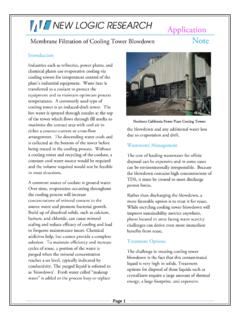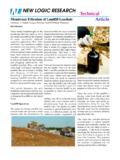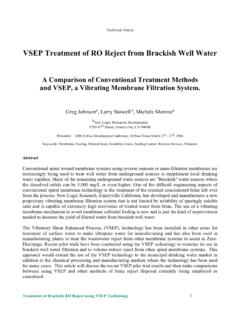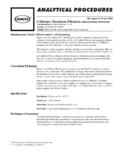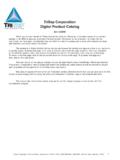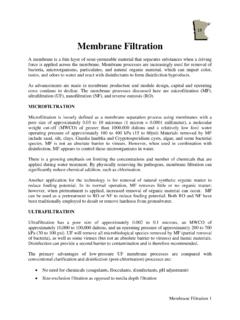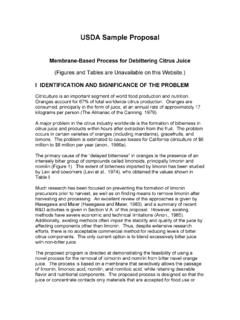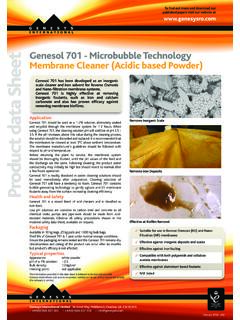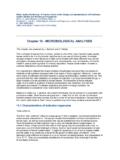Transcription of Case Using Vibrating Membranes to Study Treat Oily ...
1 V SEP .. A New Standard in Rapid SeparationCase StudyNEW LOGIC RESEARCHO verviewA unique membrane filtration system has been installed atseveral major waste oil hauling operations andmanufacturing plants that handle or produce oily system manufactured by New Logic, of EmeryvilleCalifornia near San Francisco, is also being used to processused crankcase waste oil and produce filtrate that can besold as a higher value bunker oil. The V SEP, (VibratoryShear Enhanced Process), system uses a membrane modulewith special construction for service with high temperaturesolvents and waste oils and is able to recover up to 90% ofthe oily wastewater as clean water. The use of hightemperature polymeric Membranes has many significantadvantages over the conventional methods of oily watertreatment. There are dozens of methods used for oil waterseparation. Each technique has advantages. No one techniqueis suitable for all situations. V SEP has very good overallusefulness. Membranes have the advantage of being simpleefficient separating devices to hold back oil, grease, metals,BOD, and COD.
2 They can provide clear permeate whichcan be sewered or separation technology has been around for manyyears. Initially, the use of Membranes was isolated to alaboratory scale. However, improvements over the pasttwenty years have made it possible to use Membranes on anindustrial level. A membrane is simply a synthetic barrier,which prevents the transport of certain components basedon various characteristics. Membranes are very diverse intheir nature with the one unifying theme to can be liquid or solid, homogeneous orheterogeneous and can range in thickness. They can bemanufactured to be electrically neutral, positive, negativeor bipolar. These different characteristics enable membranesto perform many different separations from reverse osmosisto micro-filtration. There are four main categories ofmembrane filtration. These are determined by the Pore sizeor Molecular Weight Cut offFiltration TypeParticle SizeMolecular WeightReverse Osmosis m 100 m100 - 1000 m1000-500,000 DaltonMicrofiltration m 500,000 DaltonUsing Vibrating Membranes toTreat Oily Wastewater from aWaste Hauling FacilityReverse Osmosis MembranesThe first category of Membranes is for Reverse are the tightest Membranes for separating are generally rated on the % of salts that they canremove from a feed stream.
3 However, they can also bespecified by Molecular Weight cutoff. Usually, the rejectionof NaCl will be greater than 95% in order to be classed asan RO membrane. The molecular weight cutoff is shown inthe table to the left. An example of their use would be forfiltering seawater in order to remove the salt. They are alsoused to remove color, fragrance and flavor from waterstreams. Reverse Osmosis Membranes don t have structuralpores. Filtration occurs as ionic species are able to diffusetheir way through the membrane SEP Membrane System installed at a majormanufacturing facility for oily water MembranesA great deal of recent research has led to the improvementof Membranes in the range of Nanofiltration. As the namesuggests, these Membranes are used to separate materialson the order of nanometers. These Membranes are notusually rated based on their pore size because the pores arevery small and difficult to measure accurately. Instead theyare rated based on the approximate molecular weight of thecomponents that they reject or the % of salts that they canremove from a stream.
4 These Membranes are usedpredominately for wastewater treatment but they are alsoused to concentrate material that has a wide range of MembranesConventional Ultrafiltration Membranes are composed ofsome type of polymer material with pores ranging from alittle less than m to m. These Membranes areused for many different separations including oilywastewater treatment, protein concentration, colloidal silicaconcentration and for the treatment of various wastewatersin the Pulp & Paper MembranesThese Membranes tend to be porous, with pores greater m. These types of Membranes are used to separate largerparticulate matter from a liquid phase. Some exampleswould be coarse minerals or paint particles, which need tobe concentrated from an aqueous WastewaterOil/Water separation covers a broad spectrum of industrialprocess operations. There are many techniques employeddepending on the situation. This summary will address thoseseparations, which are suited to the V SEPs membranetechnology.
5 The oily wastewater application can be brokendown into categories determined by the type of user and theoil/ water separation of V SEP Oily Wastewater customers:Barge/Bilge Water from marine operationsManufacturing where oily water is a waste productWaste haulers & recyclersThere is a saying: Oil and Water don t mix . This is true,but they can exist as an emulsion. Oil is not soluble in waterbut it can exist evenly dispersed as globules in water. Theconcentration of these globules is a function of mixing orstirring. If allowed to stand the emulsion will separatebecause oil is lighter than water, although, some amount ofoil globules will remain in the water. Another interestingfact is that this emulsion can exist two ways. If theconcentration of Oil is less than 50%, the water will be thesuspension fluid and the oil will be the globule. A phasetransition occurs if the oil content is more than 50%. Whenthis happens, the oil is the suspension fluid and the waterforms globules. For this reason, hydrophilic membraneseparations will be possible only when the oil content isless than 50%.
6 Commercial UsesSometimes mixing of oil and water is intentional and sometimes it is an unavoidable necessity. The following areinstances of oil water mixtures:Produced Water: Water is injected into drilling shafts todisplace oil. Barge/Bilge Water: Wash down cleaningoperations contaminated by oil. Machining Coolant: Oilmixed with water acts as a lubricant to reduce tool with Degreaser: Fluid used for cleaning oily orgreasy parts. Lubricant Manufacturing WastewaterMethods used for Oil Water SeparationCentrifugeRotary Drum Vacuum FilterDissolved Air Flotation (DAF)Slope Plate ClarifiersBiological TreatmentEvaporatorsGravity Separating DevicesV SEP .. A New Standard in Rapid SeparationCase StudyNEW LOGIC RESEARCHHighModerateLowEquipment Operating CostsCentrifugeEvaporatorVacuum Drum FilterBiologicalDissolved Air FloatationV SEP Vibrating MembraneClarifiersRelative Operating Cost comparisons of varioustechnologies for treating oily wastewaterComparisons of Oil Water Separation TechnologiesCentrifuge: Uses large horsepower motors and because ofthe number of moving parts is subject to high centrifuges are effective at removing suspendedsolids, they do not account for dissolved solids and heavymetal species in solution.
7 The effluent from a centrifugewould need further treatment prior to Drum Vacuum Filter: Quite effective at rejecting largesolids. sometimes filtrate must be sent back around to getall of the smaller particles. Usually employs coarse filters require large floor areas and have high capitalcostsDissolved Air Flotation (DAF): Large tanks where air isbubbled into the bottom and with the use of flocculants,solids are floated to the top and skimmed off. A very largetank is required due to the residence time required. Alsochemical addition is a daily if not hourly process and is asignificant operating Plate Clarifiers: Cheap and easy to use. The processrelies on gravity to drop out heavy solids. Here againcolloidal materials with small mass and dissolvedconstituents do not settle. Sometimes it is used in conjunctionwith flocculation chemicals. These chemicals have limitedeffect in dropping out heavy metals, BOD, and Treatment: This process relies on biologicalactivity to digest the solids in the wastewater.
8 The problemis that the system is extremely temperature and pH loading must be done at a set rate. The operation ofthis kind of system usually requires a very skilled also can take up a lot of floor space due to the amount ofresidence time required for the bugs to digest the : Can reduce wastewater to dry solids that canbe landfilled. Of course water re-use is not have very high capital costs and consume hugeamounts of energy even for the most efficient SEPAble to produce drinking water quality filtrate from anywastewater. Extremely energy efficient and the verticaldesign allows for a very small footprint. Does not requirepre-treatment or post-treatment for that matter. Wide rangeof Membranes available allow for precise separations basedon the process objectives. There is no chemical additionrequired except for periodical membrane of V SEP for Oily WastewaterAs with other waste streams, volume reduction is the and disposal costs are king. Wastewaters normallyhave very strict sewering rules and surcharges are attachedto anything that is sewered.
9 Since Oil is normally limited to100 ppm, oily wastewaters cannot be sewered and must betaken care of in other ways. Oil can also not be landfilled aslong as it is a liquid. Therefore, disposal of oily wastewateris an expensive operation. Volume reduction of the oilywastewater will reduce the treatment costs to dispose of thematerial. There are also many types of membrane solutionsfor oil water separation. A common membrane device usedis a tubular membrane system. One common problem withTubular Membrane Systems is the permeate quality. V SEPcan offer competitive installed costs along with RO qualitypermeate requiring less post SEP .. A New Standard in Rapid SeparationCase StudyNEW LOGIC mg/LOil & mg/LTypical Sewer Discharge Limits:Typical Sewer Discharge Limits:Concentration Polarization isthe main limiting factor tomembrane filtration with oilywastewaters. Therefore theexistence of a boundary layerof highly concentrated oil andsolids next to the membranesurface must be Membranes employcrossflow and fluid velocityto accomplish this.
10 Tubularmembranes use the sametechnique with greaterefficiency. None of these hasthe degree of efficiency of thevibrating membrane surfaceof V SEP which can useboth high crossflow velocitiesas well as high vibrational energy at the membrane surfacewhich is oscillating back and forth 55 times per comparisons based on GFD of permeate flowis difficult because there are so many variables to all things are equal and the comparison is apples andapples, V SEP will outperform the other membrane-basedtechnologies. Permeate flow rates will vary depending onthe initial concentration of oil and other materials in thefeed material as well as the % recovery which is DesignThe V SEP Machine incorporates a modular design whichmakes it compact. Because the basic design is vertical ratherthan horizontal, the needed floor space per unit is inherentlyless than other types of separations systems. The V SEPdoes require up to 17 in ceiling clearance. In most industrialapplications ceiling clearance is ample, it is floor spacewhich is of V SEP Compact Modular Design:1] Easily added into an existing system to enhance performance2] Can be installed in areas where space is at a premium3] Is easily portable and can be moved from plant to plant4] Can be installed as multiple stage systems or as single pass5] Can be chain linked to an any number depending on ] More units can be installed as production often floor space is so limited, or the system beingdesigned is so large that a separate structure is built toaccommodate the treatment system.
